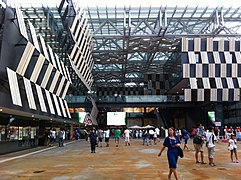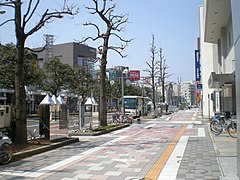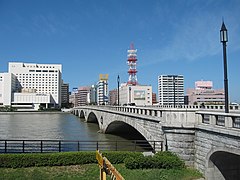Hokuriku region

Hokuriku region
The Hokuriku region (北陸地方, Hokuriku chihō, Lit. "Northlands region") was located in the northwestern part of Honshu, the main island of Japan. It lay along the Sea of Japan within the Chūbu region, which it is currently a part of.[1] It is almost equivalent to Koshi Province and Hokurikudō area in pre-modern Japan. Due to its elongated shape, and the Noto Peninsula jutting out, the region is known as a 'rising dragon' 昇龍道 (しょうりゅうどう, Shōryudō).[2][3] Since the Heian period until the Edo period the region was a core recipient of population, the population grew to be much larger proportionately than it is today, despite the rural character. With the growth of urban centers in the 20th century, particularly Tokyo and Chūkyō, the Hokuriku has steadily declined in importance to become relative backwaters. The region is also known for traditional culture that originated from elsewhere that has been long lost along the Taiheiyō Belt.
The Hokuriku region includes the four prefectures of Ishikawa, Fukui, Niigata and Toyama,[4] although Niigata is sometimes included in one of the following regions:
Shin'etsu (信越): includes Niigata and Nagano prefectures
Kōshin'etsu (甲信越): includes Niigata, Nagano and Yamanashi prefectures
Hokushin'etsu (北信越): includes both the Hokuriku and Shin'etsu regions
Contents
1 Major cities
2 Industries
3 Climate
4 Tourism
5 See also
6 Notes
7 References
Major cities
The major population centers of Hokuriku are:
Niigata (designated city)
Kanazawa, Toyama (core cities)
Fukui, Jōetsu, Nagaoka (special cities)
Of these, Niigata is the largest with a population of over 800,000.
Niigata City

Kanazawa City
Toyama City

Nagaoka City

Fukui City
Jōetsu City
Industries
The main industries in the Hokuriku area include chemicals, medicine, tourism, textiles and textile machinery, heavy machinery, farming, and fishing. Koshihikari, a popular variety of rice is a special product of Hokuriku region.
Climate

Naeba Ski Resort, Yuzawa, Niigata
The Hokuriku region has the highest volume of snowfall of any inhabited and arable region in the world.[citation needed] This is because dry Siberian air masses, which develop high humidity over the Sea of Japan, are forced upwards when they encounter the mountains of Honshū, causing the humidity to condense as snow.
The long winters and deep snow of this region are depicted in Hokuetsu Seppu, an encyclopedic work of the late Edo period which describes life in the Uonuma district of Niigata Prefecture.
The Hokuriku region is also the setting for Yasunari Kawabata's novel Snow Country.
Tourism
Hokuriku is listed as No. 4 in Lonely Planet's Best in Travel 2014 – Top 10 Regions.
http://www.lonelyplanet.com/travel-tips-and-articles/lonely-planets-best-in-travel-2014-top-10-regions
See also
- Kōshin'etsu region
- Shin'etsu region
- Tōkai region
- Tōhoku
- Kitamaebune
- Hokuriku Shinkansen
- Hokuriku Main Line
- Hokuriku Expressway
- Hokuriku dialect
Notes
^ Nussbaum, Louis-Frédéric. (2005). "Chūbu" in Japan Encyclopedia, p. 126, p. 126, at Google Books.
^ http://www.dragonroute.net/dragon_e/about.html
^ http://mitsuboshi-kaidou.com/intro/index.html
^ Nussbaum, "Hokuriku" at p. 344, p. 344, at Google Books.
References
- Nussbaum, Louis-Frédéric and Käthe Roth (2005). Japan Encyclopedia. Cambridge, Massachusetts: Harvard University Press. .mw-parser-output cite.citationfont-style:inherit.mw-parser-output .citation qquotes:"""""""'""'".mw-parser-output .citation .cs1-lock-free abackground:url("//upload.wikimedia.org/wikipedia/commons/thumb/6/65/Lock-green.svg/9px-Lock-green.svg.png")no-repeat;background-position:right .1em center.mw-parser-output .citation .cs1-lock-limited a,.mw-parser-output .citation .cs1-lock-registration abackground:url("//upload.wikimedia.org/wikipedia/commons/thumb/d/d6/Lock-gray-alt-2.svg/9px-Lock-gray-alt-2.svg.png")no-repeat;background-position:right .1em center.mw-parser-output .citation .cs1-lock-subscription abackground:url("//upload.wikimedia.org/wikipedia/commons/thumb/a/aa/Lock-red-alt-2.svg/9px-Lock-red-alt-2.svg.png")no-repeat;background-position:right .1em center.mw-parser-output .cs1-subscription,.mw-parser-output .cs1-registrationcolor:#555.mw-parser-output .cs1-subscription span,.mw-parser-output .cs1-registration spanborder-bottom:1px dotted;cursor:help.mw-parser-output .cs1-ws-icon abackground:url("//upload.wikimedia.org/wikipedia/commons/thumb/4/4c/Wikisource-logo.svg/12px-Wikisource-logo.svg.png")no-repeat;background-position:right .1em center.mw-parser-output code.cs1-codecolor:inherit;background:inherit;border:inherit;padding:inherit.mw-parser-output .cs1-hidden-errordisplay:none;font-size:100%.mw-parser-output .cs1-visible-errorfont-size:100%.mw-parser-output .cs1-maintdisplay:none;color:#33aa33;margin-left:0.3em.mw-parser-output .cs1-subscription,.mw-parser-output .cs1-registration,.mw-parser-output .cs1-formatfont-size:95%.mw-parser-output .cs1-kern-left,.mw-parser-output .cs1-kern-wl-leftpadding-left:0.2em.mw-parser-output .cs1-kern-right,.mw-parser-output .cs1-kern-wl-rightpadding-right:0.2em
OCLC 58053128.
ISBN 0-674-01753-6,
ISBN 978-0-674-01753-5.
Coordinates: 37°54′58″N 139°02′11″E / 37.91611°N 139.03639°E / 37.91611; 139.03639
This Toyama location article is a stub. You can help Wikipedia by expanding it. |
This Niigata Prefecture location article is a stub. You can help Wikipedia by expanding it. |
This Fukui Prefecture location article is a stub. You can help Wikipedia by expanding it. |
This Ishikawa Prefecture location article is a stub. You can help Wikipedia by expanding it. |







